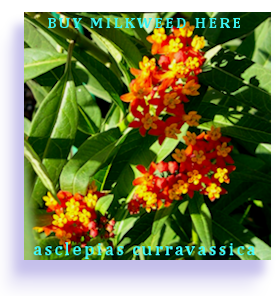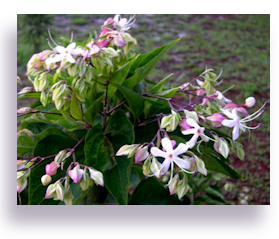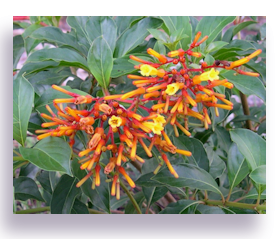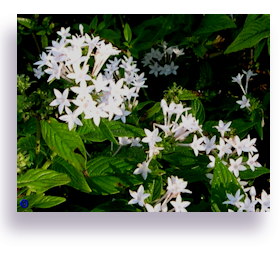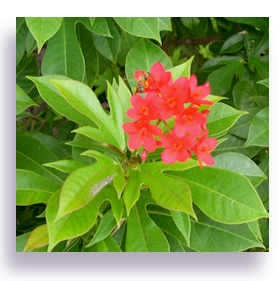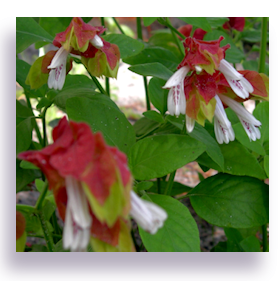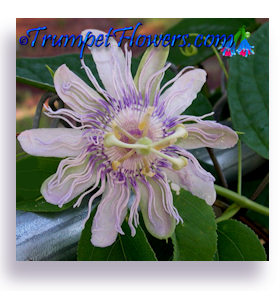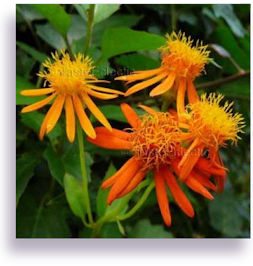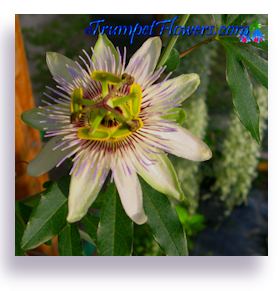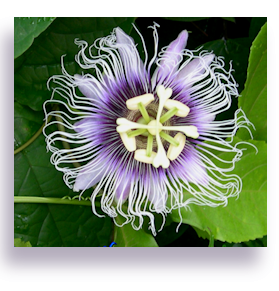Make a
Butterfly Garden
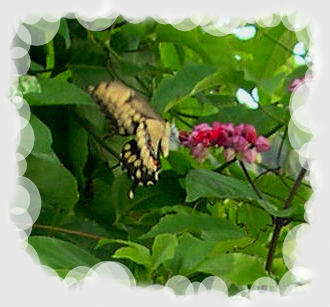 Butterfly gardening can be a rewarding hobby for you, the butterflies, and the environment. Finding out what flowers are nectar givers for the butterflies to feed from, and what plants their larvae need to feed upon, will get you set up for a lovely spectacle of blooms and rainbow colored winged jewels for many years. There are also groups of butterflies that prefer rotting fruit over nectar giving flowers, like the 'Question Mark' (Polygonia interrogationis), 'Eastern Comma' (Polygonia comma) and 'Mourning Cloak' who are also known as the Brush∼footed Butterflies (Family Nymphalidae) (Nymphalis antiopa).
Butterfly gardening can be a rewarding hobby for you, the butterflies, and the environment. Finding out what flowers are nectar givers for the butterflies to feed from, and what plants their larvae need to feed upon, will get you set up for a lovely spectacle of blooms and rainbow colored winged jewels for many years. There are also groups of butterflies that prefer rotting fruit over nectar giving flowers, like the 'Question Mark' (Polygonia interrogationis), 'Eastern Comma' (Polygonia comma) and 'Mourning Cloak' who are also known as the Brush∼footed Butterflies (Family Nymphalidae) (Nymphalis antiopa).
Getting the Garden underway
Choose a site that receives plenty of warm, full sunshine. Butterflies need the sunshine to raise their internal body temperature from overnight lows, and the nectar producing flowers they like also thrive in full sun. Creating a shallow, pebble filled depression in a cleared area that is filled with fresh water will give the butterflies some access to water. Make sure the area is free of butterfly predators, such as cats. The soil should be loamy and rich in organic material. Organically grow your Garden is a very good read once you finish here; to get your site set up for butterflies.
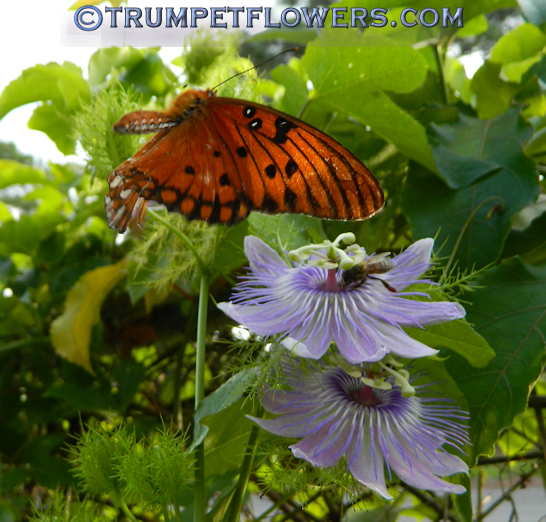
Be sure the garden is placed in such a way that you will be able to get optimum view-ability. And make sure the plants receive enough water to sustain them through their growing cycle. Perennials are the best choices, as they will form deeper roots and live much longer, coming back each spring to delight you with new flowers and many winged jewels to gaze upon.
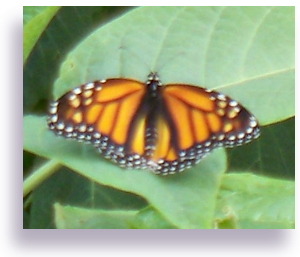 Remember when you are planning which plants to include, to choose from cultivars that will bloom at different times of the season, so that your butterflies and their caterpillars will always have something to eat.
Remember when you are planning which plants to include, to choose from cultivars that will bloom at different times of the season, so that your butterflies and their caterpillars will always have something to eat.
Some male butterflies need certain plants like Joe Pyeweed in order to create pheromones that attract the female butteflies, so make sure to grow some.
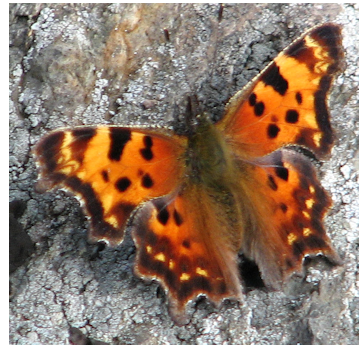 Clerodendrum quadriloculare, or the Shooting Star clerodendrum attracts beautiful orange Commas, or Polygonia comma. These butterflies have camoflauge built into their underside wings. When folded, they look like a dead leaf. It is only when they open that you see the pretty orange and brown coloration. Starburst, or Shooting Star clerodendrum flowers are favored by this butterly. You might want to sink the plant into a large, 25 gallon pot, as it suckers.
Clerodendrum quadriloculare, or the Shooting Star clerodendrum attracts beautiful orange Commas, or Polygonia comma. These butterflies have camoflauge built into their underside wings. When folded, they look like a dead leaf. It is only when they open that you see the pretty orange and brown coloration. Starburst, or Shooting Star clerodendrum flowers are favored by this butterly. You might want to sink the plant into a large, 25 gallon pot, as it suckers.
And don't forget Hamelia species, the Firebush, or Firecracker brush. This sprawling shrub attracts all sorts of butterflies, from Gulf fritillaries to Zebra longwings, all coming in for a drink of nectar from the prolific blooms that appear on the bush almost year round. This shrub receives more visits for nectar than any plant in my Butterfly garden. It can grow to 15 feet tall, but is very easy to prune to any size and outward shape you want. Makes a great hedge if you have the space. Also a fast grower.
Egyptian Starflower, or Pentas, is also a great nectar attractant. A perennial, this evergreen flower blooms in shades of red, white, purple and pink, and makes an excellent addition to any Butterfly garden.
Living in South Florida, I have found that growing several species and cultivars of passionflowers seems to have the greatest benefit to the most number of butterfly species. A lot of the common butterflies here use not only their nectar, but also use them as larval food for their caterpillars. If you are just starting up, begin with passionflower suberosa, passiflora incarnata, and passiflora caerulea. You will not only have some fast growing vines, but great fragrance, gorgeous blooms and the butterflies! I have also noticed that our state butterfly, the zebra longwing, loves passiflora suberosa, which is coincidentally, a native species of passionflower.
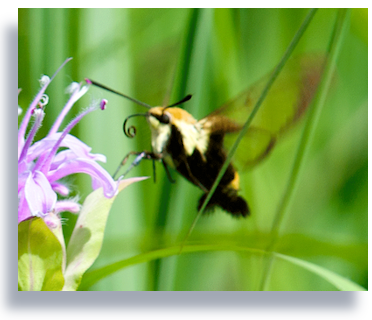 Do not forget my website's namesake, brugmansia. Angel trumpets attract many skipper moths, bees, and the scent even draws in butterflies. Although I have never seen them able to feed from the nectar of the brugmansia, because of the long tube, and their delicate wings; the perfume of the trumpet flowers does bring them into your gardens. Many species of the skipper moth remind you of hummingbirds, so are highly desired. Defintely think of brugmansia and butterfly gardening as an excellent pairing.
Do not forget my website's namesake, brugmansia. Angel trumpets attract many skipper moths, bees, and the scent even draws in butterflies. Although I have never seen them able to feed from the nectar of the brugmansia, because of the long tube, and their delicate wings; the perfume of the trumpet flowers does bring them into your gardens. Many species of the skipper moth remind you of hummingbirds, so are highly desired. Defintely think of brugmansia and butterfly gardening as an excellent pairing.
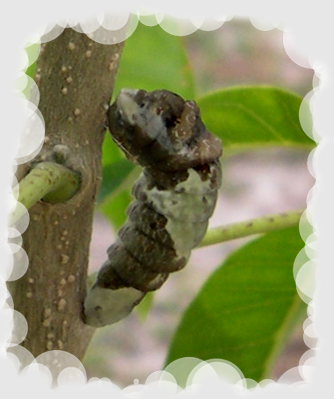 Most of all, do not use poisons of any kind anywhere near your butterfly garden. Butterflies, bees, beneficial wasps and other coveted types of insects are very delicate and the slightest misguided spray can kill months worth of your efforts.
Most of all, do not use poisons of any kind anywhere near your butterfly garden. Butterflies, bees, beneficial wasps and other coveted types of insects are very delicate and the slightest misguided spray can kill months worth of your efforts.
The caterpillar just beginning to turn into a chrysalis shown in above picture, that resembles bird dropping, is that of the Giant Swallowtail. Click here for more on the host plants used by this caterpillar.
If it is at all possible, you are going to fare better starting your plants from seeds, or buying known organically grown plants. An alarming amount of plants purchased from Big Box Stores contain posions that can harm bees and butterflies. Here is an excellent read on this: How Your Bee-Friendly Garden May Actually Be Killing Honeybees. If you aren't able to do this, at least let the plants rest in a protected area for about 8 weeks with no chemical fertilizers added, and you misting them a few times a week with a purified water foliar feed. This will allow enough time to pass that the posions should be out of the plants, systemically. Make sure to flush the soil well when watering. Only then would I plant them out in an area that the butterflies will come to.
Fertilizers for Bee and Butterfly Plants should be organic. I use only ground fish fertilizer, humic acid, and azomite as fertilizer and soil micronutrient additions.
If you are a northern gardener, remember that many butterfly larvae can and do overwinter in the leaf and yard debris. This warm, safe environment allows them to survive until spring, when they will emerge as that year's crop of butterflies. If you rake all of your yard debris up and get rid of it, so will you too be getting rid of many of your next year butterflies. Why not compromise and set aside half of the debris, untouched, just for them.
Join a couple of Butterfly organizations. Thee are several online. They can teach you more about the species that live in your region or state. Familarizing yourself with thebutterflies and their caterpillars will enable you to better protect and feed both the adults and their larvae.
Use your camera! A decent camera with a zoom lens will obtain you some frame∼worthy shots if you exercise patience. Butterflies show up in early mornings after the dew has burned off and the sun intensifies. These are also good lighting times, as well as late afternoons. When your garden is finally full of flowers and free of pesticides, you will find yourself spending hours admiring your hard work in the way of a winged spectacle that many may miss.
Cloudless sulphurs can be found here in Florida, and enjoy the cassia family, which includes senna. For more on that, read over at my page on Growing Cassia.
Involve others in your community. Teach small children the benefits of growing organic gardens, so that they can attract pollinating butterflies and bees.Sharing Mother Nature is a worthy cause and one that will make your heart smile for years to come.
We are also expanding our Butterfly Garden this year. Here's a link to the blog on it: Expanding a Butterfly Garden.
Here is a list of some great plants to start growing in that special garden plot.
- Joe Pye weed∼Eupatorium
- Maypop∼Passiflora Incarnata
- Blue Passion Flower∼Passiflora Caerulea
- Blanket flower∼Gaillardia
- Salvia∼Salvia
- Glorybower∼Clerodendrum Deliciousum
- Peanut Butter and Honey Glory Bower∼Clerodendrum trichototum
- Lantana∼Lantana sp.
- Butterfly bush∼Buddelia
- Butterfly weed∼Asclepias sp
- Love in a Mist∼Passiflora Foetida
- Firecracker or Firebush/Shrub~Hamelia Patens
- Sweet Clover
- Mexican Flame Vine∼Senecio confusus
- Passionflower vines, all kinds
- Verbena∼Verbena
- Veronica∼Veronica Spicata
- Rough Mexican clover/Florida Pusley∼Richardia scabra
- Angel's Trumpet∼Brugmansia
- Jatropha∼Jatropha compacta
- Justicia brandgeana∼Shrimp Plant
This list is Southwest Florida Butterflies & Food sources
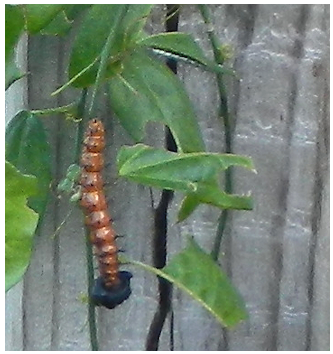
- Brush Footed Butterflies (Nymphalidae)
- Adult food sources: Flower nectar
- Larval food sources: Sugarberry (Celtis laevigata)
- Gulf Fritillary (Agraulis vanillae)
- Adult food sources: Flower nectar
- Larval food sources: Maypop (Purple) Passionflower (Passiflora incarnata) and Corkystem Passionflower (Passiflora suberosa)
- Variegated Fritillary (Eupioeta claudia)
- Adult food sources: Flower nectar
- Larval food sources: Perennial plants and Vines incl. Passiflora incarnata violets (Viola spp.)
- Julia (Dryas julia)
- Adult foodsources: Flower nectar
- Larval foodsources: Passionflowers, incl. Corkystem Passionflower (Passiflora suberosa)
- *Zebra Longwing (Heliconius charithonia)
- Adult food sources: Flower nectar
- Larval food sources: Passionflowers, incl. Passiflora incarnata & Corkystem Passionflower
- Silvery Checkerspot (Chlosyne nycteis)
- Adult food sources: Flower nectar
- Larval food sources: Asteraceae family, Woodland Sunflower (Helianthus divaricatus)
- Seminole Crescent (Anthanassa [Phyciodes] texana seminole)
- Adult food sources: Flower nectar
- Larval food sources: Herbaceous Plants∼Waterwillow (Justicia ovata)
- Cuban Crescent (Anthanassa [Phyciodes] frisia)
- Adult food sources: Flower nectar
- Larval food sources: Herbaceous Plants—(Acanthaceae) Sixangle Foldwing (Dicliptera sexangularis)
- Phaon Crescent (Phyciodes phaon)
- Adult food sources: Flower nectar
- Larval food sources: Herbaceous Plants—Turkey Tanglr Fogfruit (Phyla nodiflora)
- Pearl Crescent (Phyciodes tharos)
- Adult food sources: Flower nectar
- Larval food sources: Herbaceous Plants—(Asteraceae) (Symphyotrichum spp.)
- Question Mark (Polygonia interrogationis)
- Adult food sources: Rotting fruit, Tree sap
- Larval food sources: Sugarberry (Celtis laevigata) & Winged Elm (Ulmus alata)
- Eastern Comma (Polygonia comma)
- Adult food sources: Rotting fruits, Tree sap
- Larval food sources: Elms (Ulmus spp.); Herbaceous Plants--Nettles (Urticaceae)
- Mourning Cloak (Nymphalis antiopa)
- Adult food sources: Rotting fruit, Tree sap
- Larval food sources: Elms (Ulmus spp) and Willows (Salix spp.
- American Painted Lady (Vanessa virginiensis)
- Adult food sources: Flower nectar
- Larval food sources: Herbaceous Plants—(Asteraceae) Cudweeds (Gamochaeta [Gnaphalium] spp.)
- Red Admiral (Vanessa atalanta)
- Adult food sources: Flower nectar, tree sap, rotting fruit
- Larval food sources: False Nettle (Boehmeria cylindrica), Florida Pellitory (Parietaria floridana), & Nettles (Urtica spp.)
- Common Buckeye (Junonia coenia)
- Adult food source: Flower nectar, rotting fruit
- Larval food sources: False Foxglove (Agalinus spp.), Plantain (Plantago spp.), Twinflower (Dyschoriste spp.), Toadflax (Linaria spp.), Turkey Tangle Frogfruit (Phyla nodifloa)
- Mangrove Buckeye (Junonia evarete)
- Adult food sources: Flower nectar
- Larval food sources: Black Mangrove (Avicennia germinans)
- Tropical Buckeye (Junonia genoveva)
- Adult food sources: Flower nectar
- Larval food sources: Blue Porterweed (Stachytarpheta jamaicensis)
- White Peacock (Anartia jatrophae)
- Adult food sources: Flower nectar
- Larval food sources: Waterhyssop (Bacopa monieri) & Turkey Tangle Frogfruit (Phyla nodiflora)
- Malachite (Siproeta stelenes)
- Adult food sources: Flower nectar, rotting fruit
- Larval food sources: Herbaceous Plants—Green Shrimp Plant (Blechum pyramidatum)
- Red-spotted Purple (Basilarchia [Limenitis] arthemis astyanax)
- Adult food sources: Flower nectar, rotting fruit
- Larval food sources: Black Cherry (Prunus serotina), Carolina Willow (Salix caroliniana); Shrubs, Deerberry (Vaccinium stamineum)
- Viceroy (Basilarchia [Limenitis] archippus)
- Adult food sources: Flower nectar, rotting fruit
- Larval food sources: Willows (Salix spp.)
- Florida Purplewing (Eunica tatila)
- Adult food sources: Tree sap, rotting fruit
- Larval food sources: Crabwood (Gymnanthes lucida)
- Dingy purplewing
- Adult food sources: Tree sap, rotting fruit
- Larval food sources: Gumbo Limbo (Bursera simaruba)
- Ruddy Daggerwing (Marpesia petreus)
- Adult food sources: Flower nectar, rotting fruit, tree sap
- Larval food sources: Strangler Fig (Ficus aurea)
- Goatweed Leafwing (Anaea andrea)
- Adult food sources: Tree sap, rotting fruit
- Larval food sources: Herbaceous Plants—Silver Croton (Croton argyranthmus) and Woolly Croton (Croton capitatus)
- Adult food sources: Tree sap, rotting fruit
- Larval food sources: Pineland Croton (Croton linearis)
- Hackberry Emperor (Asterocampa celtis)
- Adult food sources: Tree sap, rotting fruit
- Larval food sources: Sugarberry (Celtis laevigata)
- Tawny Emperor (Asterocampa clyton)
- Adult food sources: Tree sap, rotting fruit
- Larval food sources: Sugarberry (Celtis laevigata)
- Southern Pearly-Eye (Enodia portlandia)
- Adult food sources: Sap, rotting fruit, vegetation
- Larval food sources: Grasses (Poaceae) —Switchcane (Arundinaria gigantea)
- Appalachian Brown (Satyrodes appalachia)
- Adult food sources: Sap, rotting fruit, vegetation
- Larval food sources: Sedges (Cyperaceae)
- Gemmed Satyr (Cyllopsis gemma)
- Adult food sources: Tree sap
- Larval food sources: Grasses (Poaceae—including Slender Woodoats Chasmanthium laxum)
- Georgia Satyr (Neonympha areolata)
- Adult food sources: Unknown
- Larval food sources: Grasses (Poaceae) and Sedges (Cyperaceae)
- Carolina Satyr (Hermeuptychia sosybius)
- Adult food sources: Flower nectar, sap
- Larval food sources: Grasses (Poaceae)—including St. Augustinegrass (Stenotaphrum secundatum)
- Little Wood Satyr (Megisto cymela)
- Adult food nectar: sap, rotting fruit, vegetation
- Larval food source: Grasses (Poaceae)
- Common Wood Nymph (Cercyonis pegala)
- Adult food sources: Flower nectar, sap, rotting fruit and vegetation
- Larval food sources: Grasses (Poaceae)
- Monarch (Danaus plexippus)
- Adult food sources: Flower nectar
- Larval food sources: Herbaceous plants (Apocynaeae)—Milkweeds (Asclepias spp.) including Pineland Milkweed (Asclepias humistrata), White Swamp Milkweed (Asclepias perennis), Pink Swamp Milkweed (Asclepias incarnata), Butterfly Weed (Asclepias tuberosa) Asclepias curravissica(Tropical milkweed)
- Queen (Danaus gilippus)
- Adult food sources: Flower nectar
- Larval food sources: Herbaceous plants (Apocynaeae)—Milkweeds (Asclepias spp.) including Pineland Milkweed (Asclepias humistrata), White Swamp Milkweed (Asclepias perennis), Pink Swamp Milkweed (Asclepias incarnata); Vines—White Twinvine (Sarcostemma clausum) Asclepias curravassica (Tropical milkweed) & Florida Milkvine (Matelea floridana)
- Soldier (Danaus eresimus)
- Adult food sources: Flower nectar
- Larval food sources: Herbaceous plants (Apocynaeae)—Milkweeds (Asclepias spp.).; Vines—White Twinvine (Sarcostemma clausum)
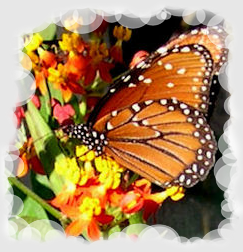 For more on North American butterflies, see my page Butterfly Gardening Links. And here's a link to a very talented lady named Stephanie in the Fort Lauderdale area who has a great website filled with photos of butterflies in our area, as well as host plants. Steph's Virtual Butterfly Garden.
For more on North American butterflies, see my page Butterfly Gardening Links. And here's a link to a very talented lady named Stephanie in the Fort Lauderdale area who has a great website filled with photos of butterflies in our area, as well as host plants. Steph's Virtual Butterfly Garden.
Tags: butterfly gardening, care and grow a butterfly garden, south florida butterfly gardening, plants for butterflies, butterfly larvae, caterpillars, butterfly gardening,

